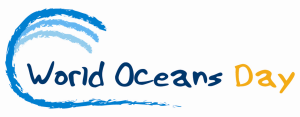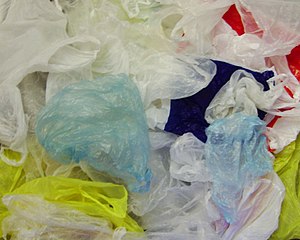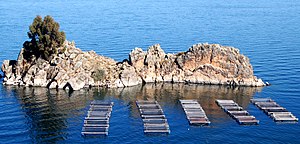On today, World Oceans Day, I’d like to bring your attention to an editorial published yesterday in the Huffington Post “Looking for a Sea Change on World Oceans Day” by Vicki Spruill, Ocean Conservancy CEO. Please share your thoughts on the article and don’t forget to wear your blue!
Adaptations
As a new mama, the wheels in my head are constantly wondering how my daughter’s surroundings will influence her personality. I sure hope she’s not bitter like the anglerfish featured in yesterday’s Sherman’s Lagoon cartoon. I will just remind the little one to keep smiling and tell her that adaptations are what led to the strongest species surviving.
The Majestic Plastic Bag – Part IV
This just in! Another fine addition to The Majestic Plastic Bag conservation series. A reusable plastic bag company, ChicoBag Company, announced recently that they are being sued by three of the nation’s largest disposable plastic bag manufacturers. Those companies are claiming that a link on the ChicoBag Company website educating citizens about the long term implications of disposable plastic bags to the environment is causing “irreparably harmed” their business.
Some of the statements that the disposable plastic bag companies have issue with are:
- “A reusable bag needs only to be used eleven times to have a lower environmental impact than using eleven disposable bags.” Source: EPA
- “Only one percent of plastic bags are recycled.” Source: EPA
- “Somewhere between 500 billion and a trillion plastic bags are consumed worldwide each year.” Source: National Geographic
- “The world’s largest landfill can be found floating between Hawaii and San Francisco. Wind and sea currents carry marine debris from all over the world to what is now known as the Great Pacific Garbage Patch. This ‘landfill’ is estimated to be twice the size of Texas and thousands of pounds of our discarded trash, mostly plastics.” Source: National Geographic
- “Each year hundreds of thousands of sea birds and marine life die from ingestible plastics mistaken for food.” Source: L.A. Times
We’ll keep you updated on how this plays out via our Twitter feed.
Related articles
- The Majestic Plastic Bag – Part II (beachchairscientist.wordpress.com)
- The Majestic Plastic Bag – Part III (beachchairscientist.wordpress.com)
- Reusable Shopping Bags: Making the Switch (everydayhealth.com)
- Plastic Bags: Just Say “No” (greenwithoutgreen.wordpress.com)
- A Worldwide Survey of Plastic Bag Bans & Waste (Infographic) (treehugger.com)
The Majestic Plastic Bag – Part III
Two months ago, the esteemed Carl Safina posted a piece titled, “For Seabirds As For The Graduate, One Word: Plastics“. It seems a suitable tie-in for the The Majestic Bag conservation series.
For Seabirds As For The Graduate, One Word: Plastics.
 If something can be neither fish nor fowl, for seabirds this is neither feast nor famine: scientists are discovering more species eating more—plastic.
If something can be neither fish nor fowl, for seabirds this is neither feast nor famine: scientists are discovering more species eating more—plastic.
An article in the Ottawa Citizen reports that in the Canadian Arctic, startled scientists “are pulling remarkable amounts of trash from birds in some of the remotest spots on Earth.”
Pacific albatrosses are famous for eating plastic. Now Canadian scientists are finding plastics in sturdy cousins of albatrosses called Fulmars; 85 percent of Canadian Fulmars now have plastic in their bodies. “I find these plastic pieces packed up around the bottom of the stomach and around the sphincter that leads into the intestine,” said Jennifer Provencher, who had been doing dissections. One gull-sized Fulmar, for example, had what looked like a red Coke cap and 20 other plastic pieces in it. Provencher called the amount of plastic she discovered in Arctic Canadian seabirds, “hard to believe.”
But in European waters, it’s worse: Fulmars there are now loaded with an average of 40 pieces of plastic. Virtually all European Fulmars now fly around with plastic in their bodies.
And, it’s increasing. Biologist Stephanie Avery-Gomm, opened stomachs of 36 Fulmars that washed up on Vancouver Island after a storm. One contained several dozen pieces of plastic, including industrial pellets, a chunk of sponge, fishing line and a bristle from a hairbrush. In a study of bird diets done back in the 1970s, Fulmar stomachs had contained no plastic.
“Every time we sample we are surprised by the amount of plastics we find,” said Provencher.
Another surprise: more species now contain plastics, including the normally non-scavening Thick-billed Murre. Fulmars were already known plastic swallowers, but “What was shocking was to open up the murres and find plastics,” Provencher said. Eleven percent of 186 Thick-billed murres examined carried plastics.
The plastics are coming not just from boats. They’re from us all. In North America and Western Europe the average person is now using around 220 pounds of plastic a year. Needless to say, that’s expected to increase. In Asia the average person uses around 80 pounds of plastic per year, and that’s expected to nearly double by 2015.
Read what the United Nations Environment Program’s 2011 Yearbook has to say about plastics in the ocean.
It’s a nightmare.
So my question is: Why do we use an eternal material to package items intended for one-time use? No one expects such items like yogurt and salad to stay in the distribution chain for more than a couple of weeks. Why don’t we package things like perishable food—and everything else not intended to last forever—in plant-based plastic that will break down in a year?
It could easily be done. The materials already exist. For instance: http://www.metabolix.com/
Related articles
- The Majestic Plastic Bag – Part II (beachchairscientist.wordpress.com)
- Recycling: Just Do It (mkmercurio.wordpress.com)
- Grocery Bag Rings – Giovannie Scafuro Creates Eco-Chic Jewelry From Old Plastic (TrendHunter.com) (trendhunter.com)
- Seabirds pay the ultimate price for plastic pollution (theage.com.au)
The Majestic Plastic Bag – Part II
Yesterday we brought you the “mockumentary”, The Majestic Plastic Bag. As a follow-up today check out this amazing infographic from reusablebag.com. Ireland reduced plastic bag consumption by 90% (1 billion bags!) from 2001-2011 by imposing a tax of 37-cents.

Source: Reusable Grocery Bags
image (c) http://www.reusethisbag.com
Related articles
- A Worldwide Survey of Plastic Bag Bans & Waste (Infographic) (treehugger.com)
The Majestic Plastic Bag
Narrated by Jeremy Irons, here is a clip from the “mockumentary”, The Majestic Plastic Bag.
5 facts about fish farming
Here are five facts about the glory and challenges of fish farming. Fish farming and aquaculture has really stepped up due to the demand for the world’s fish consumption, but maybe not in the most sustainable manner like Linda Thornton.
1.) It’s polluting our water
It seems as though large fish farm like to cram fish to live in very tight spaces. A large amount of fish would lead to a large amount of waste produced by the fish. Also, the unfavorable conditions often lead to disease. Fish farmers tend to treat the disease and infection with harmful antibiotics which further harm the surrounding waterways.
2.) It brings untested chemicals to your dinner plate
It seems as though many of the antibiotics used to treat diseases on foreign fish farms are commonly made of chemical banned in the US. Since there is no regulation often these harmful chemicals make their way to your dinner table.
3.) It’s tearing apart mangroves
Shrimp farmers are tearing apart the mangroves to make way for their new crop of this popular crustacean. However, this destroys a delicate nursery ground for many local fish species. In turn this depletion in resources severely affects local economies. What makes matters worse is that often these shrimp farms are abandoned in order to find better producing areas.
4.) It’s often counter-productive
Fish farms can be tough to maintain, especially for salmon and other carnivorous species. They tend to eat more food than they actually produce! This is turn leads to a lot of waste that can disturb the balance of the surrounding waterways.
5.) It does good things!
Some fish farms raise species that are actually clear out pollutants from the water. Bivalves (oysters, mussels, etc.) are filter feeders and cleanse their aquatic habitat! Also, tilapia are herbivores and do not require as much input as the carnivorous farmed fish need.
Related articles
- Fish farm sues activist for defamation (theglobeandmail.com)
- http://www.huffingtonpost.com/2010/03/31/9-surprising-fish-farming_n_518724.html#s77073&title=Production
- Tasting the future of farmed seafood (cnn.com)
- Another Side of Tilapia, the Perfect Factory Fish (nytimes.com)
- The Many Faces of Aquaculture: An Introduction to Fish Farming (marksdailyapple.com)
May 23 is World Turtle Day
Did you know that almost half the world’s turtle species are considered threatened?
Founded in 1990, the American Tortoise Rescue sponsors May 23rd each year to “increase respect and knowledge for the world’s oldest creatures”.
Here is a link where you can learn more about sea turtles. Please take some time to share your knowledge about these ancient creatures with your friends and family!
Test your knowledge: National Ocean Science Bowl biology
Here are some more sample questions from the Consortium for Ocean Leadership‘s popular National Ocean Science Bowl (NOSB). These questions come from the Biology section.
Good luck!
1) Northern elephant seals come ashore during the spring and summer to do what? a) Mate b) Eat c) Give birth d) Shed their fur
2) The habitat of blue whales, tunas and swordfishes is best described as: a) Benthic b) Littoral c) Estuarine d) Pelagic
3) Intensive aquaculture of which of the following organisms has contributed to loss of mangroves around the world? a) Tilapia b) Cod c) Salmon d) Shrimp
4) Lophelia (LO-fee-lee-ua) coral reefs in the North Atlantic are being primarily damaged by: a) Pfiesteria b) Poisoning c) Rising temperatures d) Trawling
Related articles
- Science Bowl team wins $1,000 in D.C. (timesunion.com)
“Always read something that will make you look good if you die in the middle of it.” P.J. O’Rourke
Today Ira Flatow discussed summer science reads on Science Friday, my favorite radio program. So, I got to thinking about two very special books that I always wander back to when I want to reconnect with the ocean. Henry Beston’s, The Outermost House, and Jennifer Ackerman’s, Notes from the Shore, are two books written in the spirit and tradition of Thoreau’s, Walden. Beston and Ackerman are alone with their thoughts in a remote marine environment (Beston is on Cape Cod while Ackerman is on Delaware’s Cape Henelope) for an extended period of time. They both contemplate how the ocean can be a metaphor for our existence.
After his return from World War I, Beston built a writer’s cabin on Cape Cod. He called the home Fo’castle and there he wrote The Outermost House published in 1928. This book was an inspiration to Rachel Carson as she wrote The Sea Around Us. Fo’castle was unfortunately destroyed by high tides in 1978.
Here is an excerpt from The Outermost House that I come back to often (especially when I am coveting the latest smartphone): “Touch the earth, love the earth, her plains, her valleys, her hills, and her seas; rest your spirit in her solitary places. For the gifts of life are the earth’s and they are given to all, and they are the songs of birds at daybreak, Orion and the Bear, and the dawn seen over the ocean from the beach. ”
Let’s face it. Beston is not for everyone. Jennifer Ackerman is a bit most contemporary in her text and prose. After all, Notes from the Shore was published in 1995. Her outlook on man altering nature is spot-on, “It’s in our nature to see order and when we don’t see it, to try to impose it. We have to put things through our minds to make sense of them, and our minds crave pattern and order. So maybe what we glimpse is only what we desire.” A statement that reminds me sometimes we should just allow nature to take its course and see what happens.
her text and prose. After all, Notes from the Shore was published in 1995. Her outlook on man altering nature is spot-on, “It’s in our nature to see order and when we don’t see it, to try to impose it. We have to put things through our minds to make sense of them, and our minds crave pattern and order. So maybe what we glimpse is only what we desire.” A statement that reminds me sometimes we should just allow nature to take its course and see what happens.
Another reason I gravitate to Notes from the Shore is that she spends a considerable amount of time writing about my favorite animal, Limulus polyphemus. She even reviews her experience counting horseshoe crabs during the late nights in May and June, an activity this Beach Chair Scientist did quite often during undergraduate internships. With that I will leave off with Ackerman’s description on the incredible nature of the horseshoe crab‘s ability to remain so steadfast and unchanged, “These creatures so durable that they antedate most other life-forms, so adaptable that their survival as a species may, for all we know, approach eternity.”
Image (c) goodreads.com
Related articles
- It’s as Easy as A, B, Sea: A Review (beachchairscientist.wordpress.com)












What people are saying …